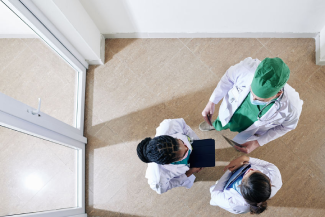Wintertime Blues: A Need for Interprofessionalism in Patient Care
February 5, 2019
Northeast Ohio is now being enveloped by a polar vortex. The subzero temperatures put everyone at risk, but our patients with chronic wounds are especially vulnerable. Neuropathy can desensitize them to the cold and result in frostbite. Inadequate shelter and heat, and an inability to go to health care appointments, shop for food, or pick up (or even afford) prescriptions and wound care products can have devastating effects.
For the past few years, as health care has become more complex and decentralized, efforts have been made to encourage patients to have a "medical home." Depending on where you live, this can be difficult to achieve with the current dearth of primary care providers. This makes communication and collaboration among health care providers and our patients essential.
Embracing Interdisciplinary Communication
From my first days of nursing school, communication skills were emphasized as an essential part of professional nursing care. Over the years, multidisciplinary and interdisciplinary communication coupled with efforts to embrace patient-centered care have been met with varying degree of success. The advent of electronic medical records helped to capture essential information and documentation, however, it has been reported that the multiple screens and keystrokes needed to access records may discourage some heath care providers from reading one another's documentation.
The fall 2018 issue of Pitt Nurse, published by the University of Pittsburgh School of Nursing, focused on interprofessionalism among various health care disciplines to improve health care and health care outcomes. They have implemented a program where nursing students take courses with and work alongside students in the University of Pittsburgh College of Medicine and Dentistry. The ultimate goal is to establish how essential it is for the various disciplines to interact, communicate, and respect one another's role in the health care team throughout their professional careers. Interprofessionalism is important among all disciplines: physical therapists, social workers, nurses, and doctors all need to have open lines of communication.
Steven Covey, author of The 7 Habits of Highly Effective People, is quoted as saying, "Trust is the glue of life. It's the most essential ingredient in effective communication. It's the foundational principle that holds all relationships." Far too often, health care providers find themselves, frequently unintentionally, engaged in "parallel play." Unlike preschoolers, who may be sitting side by side playing with Legos yet not interacting, when we as health care providers engage in similar behavior, the results can be disastrous.
The co-founders of wound, ostomy, and continence nursing (then known as enterostomal therapy [ET] nursing), who also established the first formal program of study at the Cleveland Clinic, Rupert B. Turnbull, Jr, MD and Norma N. Gill, felt strongly that the "ETs" and colorectal surgeons and Fellows should establish a strong bond during their training programs. The surgeons and fellows were active participants in both the lecture and clinical portions of the ET program. The fellows in turn were required to spend a clinical rotation shadowing an experienced ET. Those experiences led to appreciation of one another's role, as well as enhanced open communication between the disciplines.
Every person involved in the care of a patient needs to be valued and respected for the particular skill set they bring to the health care delivery system. Trust and communication are essential to providing holistic, comprehensive, and effective patient care across the health care continuum. Communication and follow-up by team members support positive outcomes by linking our patients and their caregivers with resources to help them through the inevitable bumps—and polar vortexes—that occur on the road of life.
About the Author
Paula Erwin-Toth has over 30 years of experience in wound, ostomy and continence care. She is a well-known author, lecturer and patient advocate who is dedicated to improving the care of people with wounds, ostomies and incontinence in the US and abroad.
The views and opinions expressed in this content are solely those of the contributor, and do not represent the views of WoundSource, HMP Global, its affiliates, or subsidiary companies.










